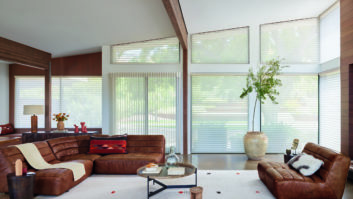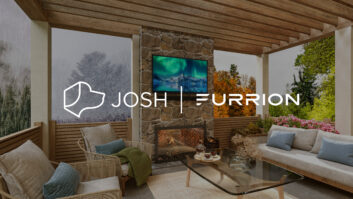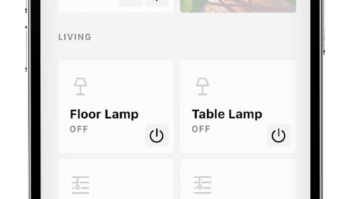
“Staying relevant is like breathing. If you don’t, you will die,” stated veteran custom integrator, Scott Fuelling, when describing the products and technologies that help keep his business competitive in today’s ever-increasing DIY consumer electronics environment with eroding equipment margins.
It’s not easy for Fuelling, president of Memphisbased Phoenix Unequaled Home Entertainment, to remain bullish on the industry’s future, but he believes that staying nimble will increase his company’s chances for success.
“Technology is ever changing and, of course, that is what continues to drive opportunities for custom integrators,” Fuelling explained. “But as with so many professions, [you must] take the time to learn the technology inside and out and then determine how to offer it to your clients in a manner in which they see value.”
Many savvy integrators are turning to exclusive product categories like window shades, high-end lighting controls, robust integration solutions, and other premium technologies to set themselves apart from mass-market threats and offer true value to their clients. Fuelling said that he believes savvy integrators should look to enhance their IT offerings with advanced home networking, home servers, and off-site data storage solutions.
“With cloud-based computing gaining more and more relevance, not to mention popularity, more clients will be looking to trusted outside firms to set up and manage their networks, as well as remote access to their data,” he said.

Despite a move toward iPad solutions and more intuitive media management options, Fuelling still believes an opportunity exists for CIs to to provide clients with even easier access to their media. “I think too many integrators fail to properly understand and manage these needs by providing an intuitive solution that is not only available in the client’s home, but also available to them remotely,” he noted. “Obviously there are many ways to accomplish this, so each integrator should look at their vendor partners’ offerings and come up with a standard solution that can be implemented regardless of the client’s preferences,” Fuelling concluded.
EJ Feulner, managing director for Elite Home Technologies in Broomal, PA, said it is more important than ever for integrators to focus on products and solutions that both increase the reliability and user experience for clients and the bottom line of their businesses. “An obvious example is networking for which there are dedicated providers in our channel that offer robust performance and real profit margins,” he said. “Looking beyond that [there are] installed integrated systems that will always require our experience and knowledge to make work. It is ultimately up to us to strengthen our sales skills to sell these systems against the DIY solutions that many potential clients are considering.”
Mark LaFave believes that big-box stores cannot hope to compete with CIs in networking, lighting control and motorized window treatments. The Digital Playground director for Maverick Integration in Bedford, NH, said that, “All three areas are robust sources of new-found business for us. Window treatments stand out as a terrific topic because integration companies are scared of the topic. That fear leaves opportunity in the wake.”

Sean Weiner, president of Starr Systems Design in Baltimore believes that while technology advancements are “the life blood of the CI world,” unfortunately there “aren’t a whole lot of products that will help us stand out in the marketplace.” That being said, Weiner is looking to energy monitoring/ management, security, and motorized shading as categories to help separate his company from the mass market, and is already working on supplying enterprisegrade networks to clients as well. But the one area where he believes companies like his can differentiate themselves is with products from Trufig, which help make mundane products like dimmer switches, air vents, and iPad mounts disappear into the wall.
“Design-oriented clients not only want the technology, but they want it to blend with their homes,” Weiner said. “There’s something pretty special about making all this stuff disappear. An iPad stuck to the wall is functional, but an iPad that’s completely flush with the wall is functional, cool looking, and unique. Our clients enjoy being different than the masses. These products can be very appealing.”
Weiner also pointed to “outdoor entertainment” as an opportunity for CIs to stand out. “Working with landscape architects and landscape contractors is not something the big-box crews are accustomed to,” he said. “Installing a pair of speakers on a wall is one thing, but a complete outdoor theater, or a hidden music system that provides high performance over a large area is right in the wheelhouse of an experienced CI.”
John Sciacca, principal with Custom Theater and Audio in Myrtle Beach, SC, distilled the technology goals of the CI channel into four points. Any new product or service, he said, needs to one that can’t be price shopped online or at big-box stores, has a somewhat protected dealer base, can’t be installed by the end user, and provides a unique experience that people don’t already have. The product that most fits this bill, in Sciacca’s opinion, is automation.

“Because of the advanced programming and training required, you’ll never see Control4 and Crestron and Savant systems sold online, because an end-user could never install them,” Sciacca said. “Again, due to the training requirements, you don’t see these items readily sold through distribution, either. And the vast majority of people are still controlling their lighting and HVAC systems the same way their great grandparents did. Automation provides that, ‘wow’ experience that installers used to deliver with a home theater demo. And since control should be a part of every system we install, adding automation is a natural.”
Gordon van Zuiden, president of cyberManor in Palo Alto, CA, took that idea even further, predicting that savvy integrators should become the “custom integrator for the smartphone and tablet application-enabled home.”
“This includes the unconventional systems, such as door locks, hot tub and pool control, irrigation systems, lighting control and motorized window treatments; utility management and control (electricity, gas, and water), and enterprise network solutions,” he stated. “It will also include remote access solutions (for lights, thermostats, entertainment, energy control), wholehouse audio and video distribution over IP (including all mobile devices), and customized ‘invisible’ technology solutions that includes eliminating ‘wall acne’ control points.”
Tom Stone, principal of Stone Glidden in King of Prussia, PA, offered “high-quality streaming audio” as one of his top three categories. “Instead of proposing a Sonos ZP 120-amp with an average set of in-ceiling speakers, we are getting traction taking the Sonos ZP90 preamp into Music Fidelity DACs, each feeding a zone of a beefy multichannel amp (AudioControl and Lexicon), playing over upperend in-ceiling speakers. Not everyone springs for it, but some do, and it triples the price of the upgrade.”
Stone agreed that enterprise-level networks are also becoming a necessity and an easier upgrade than in years past. “Clients are tired of [subpar] wireless and network bog downs,” he said. “When properly explained, they are opting for better hardware (Pakedge) that we are proposing.”

Whole-house lighting and shades have “exploded” for Stone Glidden in 2012, and Stone is one of many who feel it will be a winning category in 2013, as well. “The roll out of super-charged apps like Lutron’s have provided the ‘wow’ factor for clients looking to justify the cost. Integrators should actively tout the benefits of using a lighting designer as well, as the experience of lighting control goes through the roof when a properly lit space is mated with a control system. In other words, a client will like the lighting control system you installed … they will love it if it’s controlling a lighting layout that has been professionally specified and designed.”
Residential Systems contributor Todd Anthony Puma, owner of The Source Home Theater in New York City, concluded that “custom” means tailoring an installation to the tastes of a specific client, no matter what specific products or technologies are being used. “Get to know them, what they like, and what they expect from their system,” he explained. “Then take it one step further. Our industry offers so many products and techniques to give clients that ‘wow’ factor, whether it be artwork TVs, building a projector screen into the ceiling for a drop-down effect, or incorporating all of their daily tasks into a remote where they have control of their entire home at the tip of their fingers. We, as custom integrators, have the opportunity to take our client’s leisure time and transform it into not only a chance for them to unwind and entertain, but to something that they are proud to show off when their friends come over.”
Jeremy Glowacki is editorial director of Residential Systems.
Why Room Acoustics Matter to Your Bottom Line
By Mark Weisenberg

Room acoustics is a product/service that could provide custom integrators with a unique value proposition compared against mass-market retail offerings. Understanding and applying room acoustics to the design and installation of an audio system is a fundamental element that enhances a system’s perceived quality and value, yet CI industry integrators almost always overlook it.
Proper placement, direction, and relative volume are all critically important to delivering the best sound a room can offer, regardless of the components being used. But it’s not just about science, it’s about business. Audio systems that are acoustically optimized for a specific room maximize every dollar of the client’s investment and allow the integrator to convey their value as a professional installer. Applying room acoustics is a crucial step to unleash the full performance capabilities of today’s increasingly sophisticated audio systems, and it will show the client that not only do you know the best equipment to use, but you know exactly how to use it best. That’s something people can’t get online or at Best Buy, and every time you impress a client, it can lead to repeat business or referrals.
Today’s audio consumer has access to more content than ever before and may listen to TV, movies, music, and even talk radio through the same system. So installation techniques need to live up to the sophistication of the components themselves. Every integrator should buy the book “Sound Reproduction: The Acoustics and Psychoacoustics of Loudspeakers and Rooms,” written by Dr. Floyd Toole, one of the foremost experts on sound reproduction and room acoustics. It’s an incredibly helpful reference and teaching tool that allows integrators to dramatically improve their audio installations and amaze their clients with advanced technical knowledge they won’t find online.







